You don’t need to wait months for indoor blooms when these fast-growing flowering plants can transform your space in weeks. While most houseplants focus on foliage, these varieties deliver both greenery and vibrant flowers with minimal effort. From the low-maintenance Peace Lily to the striking Anthurium, each plant offers unique colors and growing patterns that’ll brighten any room. Let’s explore which quick-blooming varieties will suit your indoor garden best.
Contents
1. Peace Lily
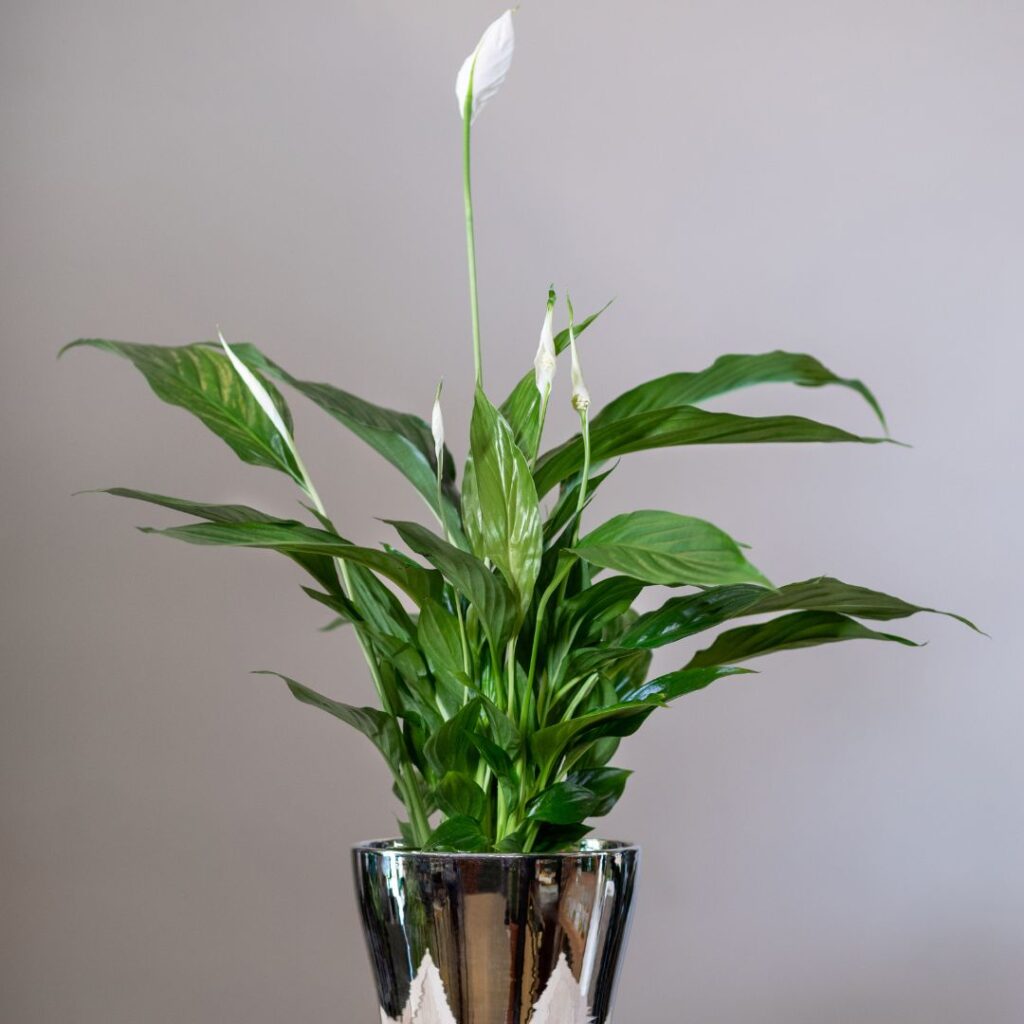
Peace Lily (Spathiphyllum) is a popular indoor flowering plant known for its relatively quick blooming cycle, typically producing white, hood-like flowers within 6-8 weeks under proper conditions. This tropical plant features glossy dark green leaves and elegant white spathes that can bloom multiple times throughout the year, making it an excellent choice for indoor gardeners seeking fast results. Its air-purifying qualities and adaptability to indoor environments have made it a favorite among houseplant enthusiasts.
- Light: Bright indirect light; can tolerate low light but may not flower as prolifically; avoid direct sunlight
- Water: Keep soil consistently moist but not waterlogged; water when top inch of soil feels dry
- Soil: Well-draining, rich potting mix with organic matter
- Temperature: 65-80°F (18-27°C)
- Humidity: Prefers high humidity; mist regularly or use a humidity tray
- Fertilizer: Monthly feeding with balanced liquid fertilizer during growing season
- Pot: Container with drainage holes
- pH: 5.0-6.5
2. African Violet
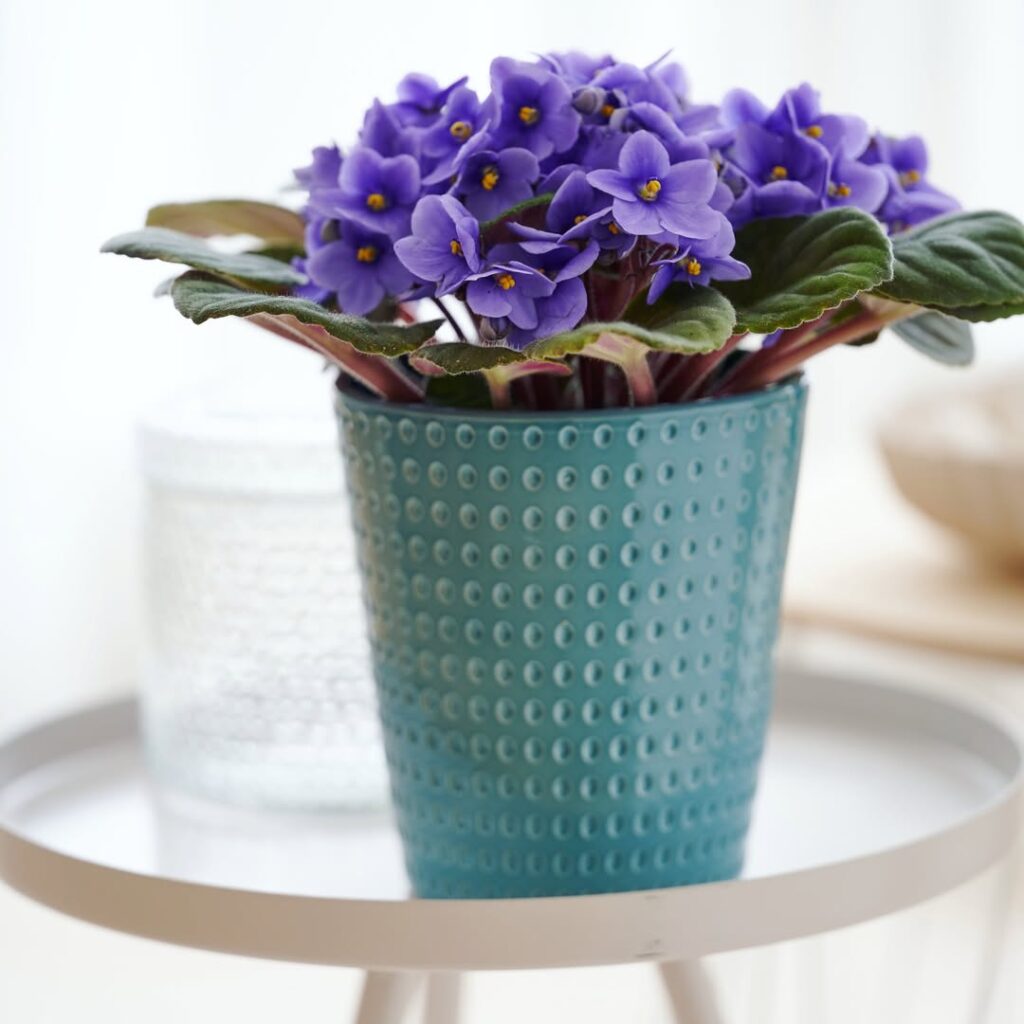
African Violets (Saintpaulia) are compact, fast-growing flowering houseplants that can bloom multiple times throughout the year when properly cared for. These charming plants produce clusters of purple, pink, white, or blue flowers above fuzzy, dark green leaves, and can go from propagation to flowering in as little as 8-12 weeks, making them one of the quickest indoor blooming plants available.
- Light: Bright, indirect light; avoid direct sunlight; 12-14 hours of artificial light if natural light is insufficient
- Water: Keep soil consistently moist but not waterlogged; water from bottom when top inch feels dry
- Soil: Light, well-draining African violet potting mix with high organic matter
- Temperature: 65-75°F (18-24°C)
- Humidity: 40-60%; use humidity tray if needed
- Fertilizer: Balanced, water-soluble fertilizer designed for African violets every 2-4 weeks
- Container: Small pot with drainage holes; prefer being slightly root-bound
- pH: 6.0-6.5
3. Orchid
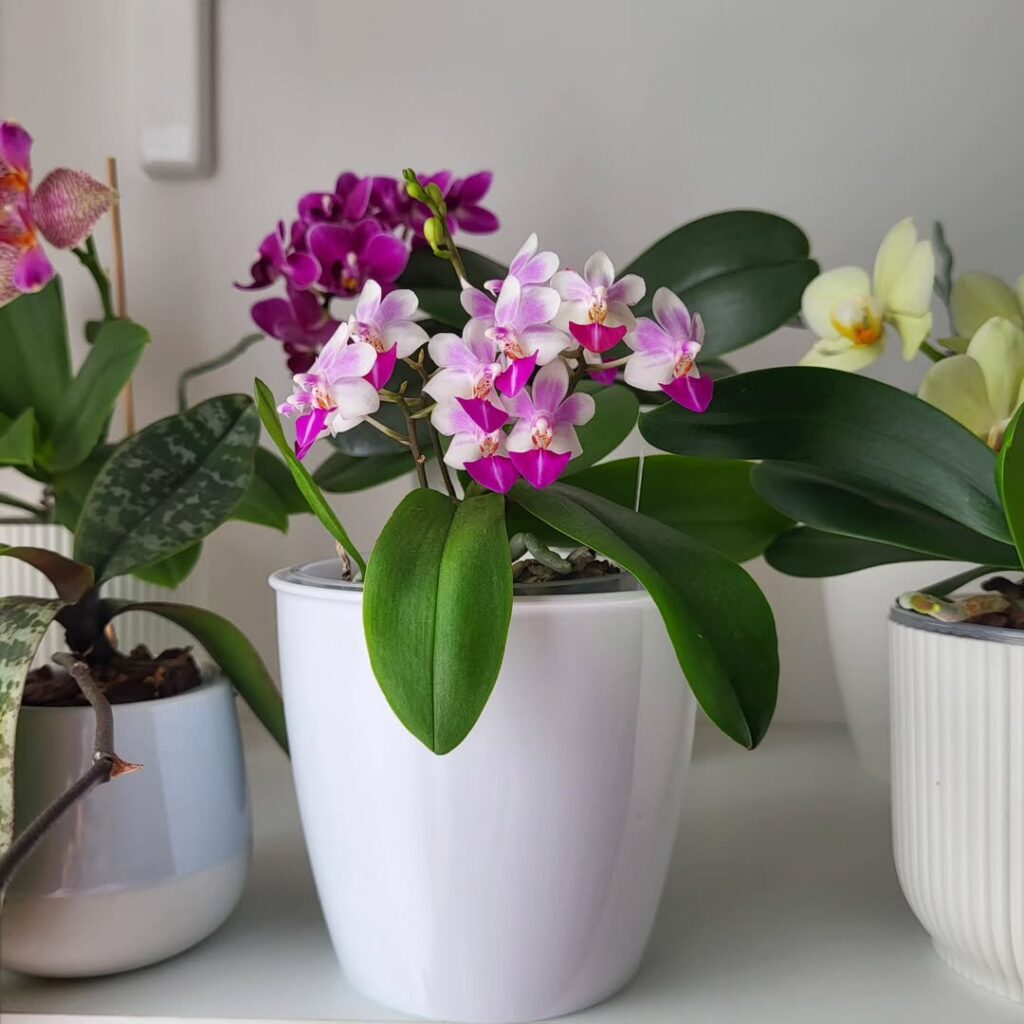
Blooming potted orchids, particularly Phalaenopsis (moth orchids), are popular indoor plants that can flower multiple times per year when properly cared for. These elegant plants produce long-lasting blooms in various colors including white, pink, purple, and yellow, with individual flowers remaining fresh for several weeks to months. The orchid’s distinctive flowers grow on graceful stems that arch above thick, oval-shaped leaves, making them attractive even when not in bloom.
- Light: Bright, indirect sunlight; avoid direct sun which can burn leaves; east or north-facing windows are ideal
- Water: Water thoroughly when potting medium feels dry; typically once per week; avoid letting roots sit in water
- Humidity: 50-70%; use humidity tray or mist regularly
- Temperature: 65-80°F (18-27°C) during day; slightly cooler at night
- Growing Medium: Special orchid mix containing bark, perlite, and sphagnum moss; never use regular potting soil
- Fertilizer: Balanced orchid fertilizer every 2-4 weeks during growing season
- Container: Well-draining pot with plenty of ventilation holes
- Air Circulation: Good airflow to prevent root rot and fungal issues
4. Anthurium
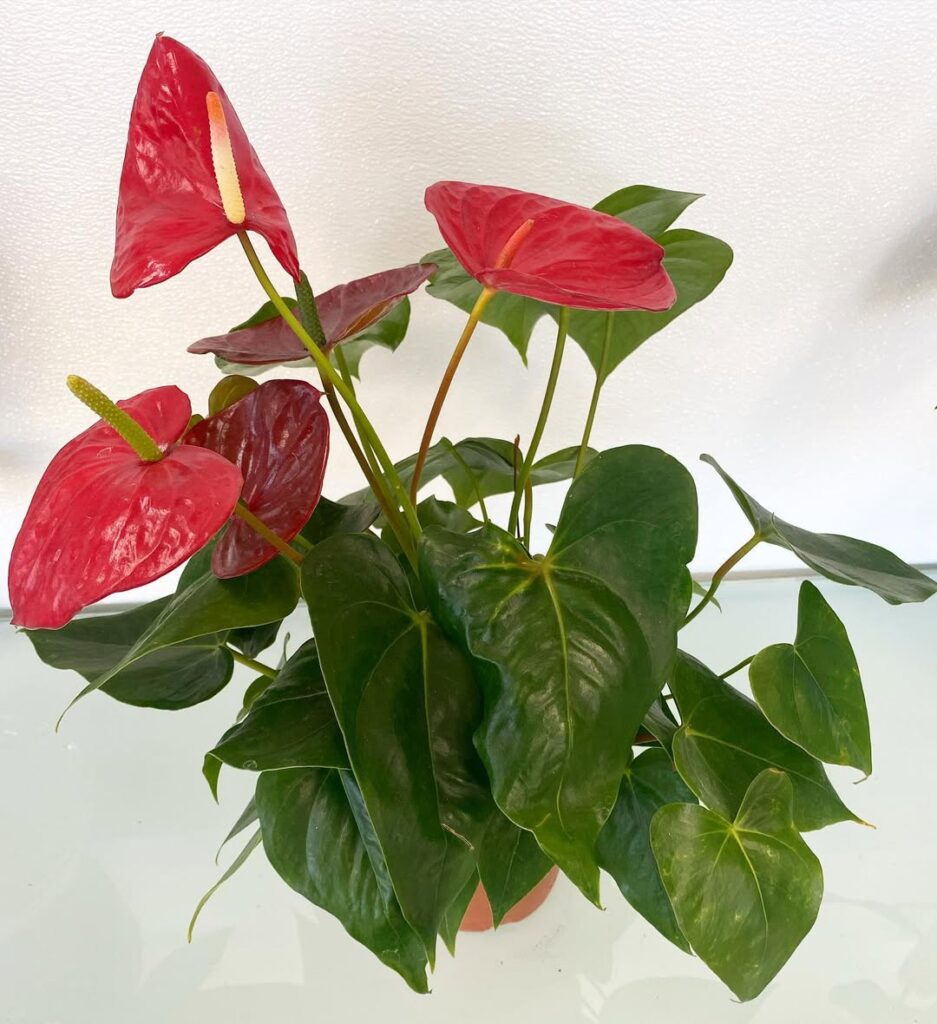
Anthurium is one of the fastest-blooming indoor plants, capable of producing vibrant heart-shaped flowers year-round under proper conditions. Known for their glossy, waxy blooms in shades of red, pink, and white, these tropical plants can flower every six weeks, with each bloom lasting up to eight weeks. The actual “flower” is a spadix, surrounded by a modified leaf called a spathe, which gives Anthurium its distinctive appearance and lasting color.
- Light: Bright, indirect light; avoid direct sunlight which can burn leaves
- Water: Keep soil consistently moist but not waterlogged; water when top inch of soil feels dry
- Soil: Well-draining, loose potting mix rich in organic matter
- Humidity: High humidity (60-80%); benefits from regular misting or humidity tray
- Temperature: 70-85°F (21-29°C)
- Fertilizer: Feed monthly with balanced, phosphorus-rich fertilizer during growing season
- Pot requirements: Container with good drainage holes
- Soil pH: 5.5-6.5
5. Christmas Cactus
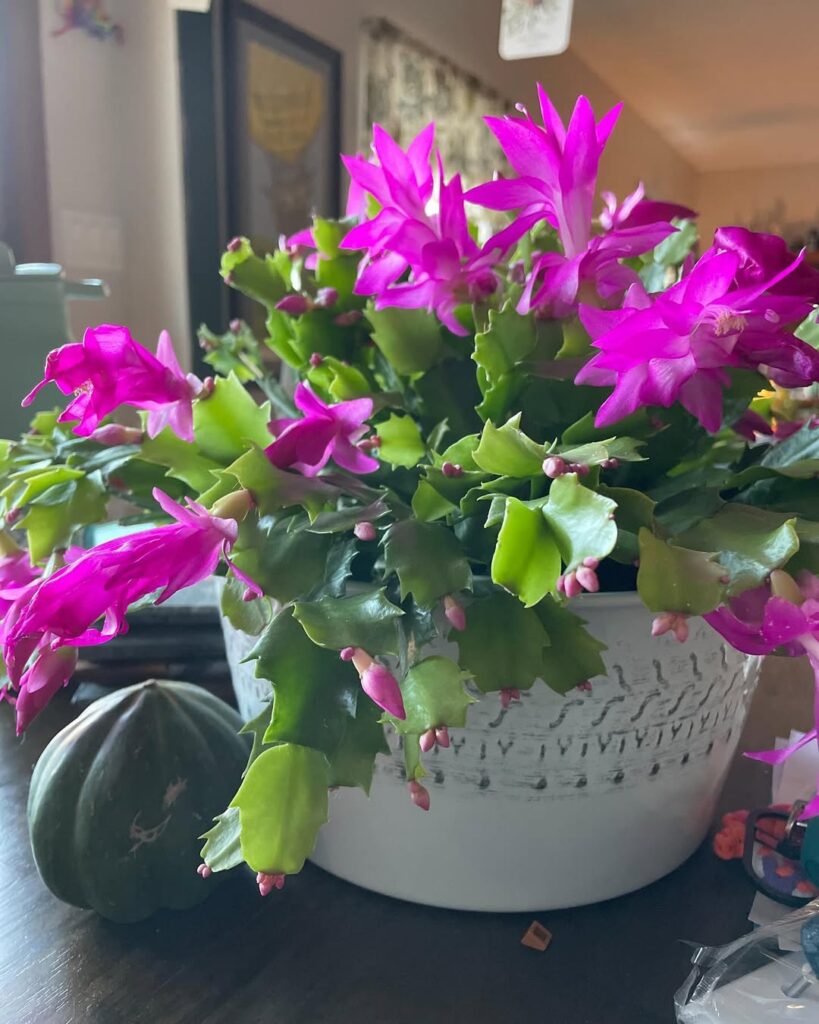
A Christmas Cactus (Schlumbergera) produces vibrant blooms in shades of pink, red, white, or purple during the winter months, typically around the holiday season. This flowering succulent, native to Brazilian rainforests, features flat, segmented stems and can bloom multiple times per year when properly cared for. The blooms last for several weeks, making it an excellent choice for indoor gardens seeking reliable winter color.
- Light: Bright, indirect light; avoid direct sunlight which can burn leaves; low light during fall induces blooming
- Water: Keep soil moderately moist during growing season; reduce watering in fall to trigger flowering
- Soil: Well-draining potting mix with added organic matter; mix equal parts potting soil and sand
- Temperature: 65-75°F (18-24°C) during growing season; cooler temperatures (55-65°F) trigger blooming
- Humidity: 50-60% humidity; benefits from occasional misting
- Fertilizer: Monthly feeding with balanced fertilizer during growing season; stop during blooming period
- Container: Use pot with drainage holes; slightly root-bound conditions encourage flowering
6. Kalanchoe
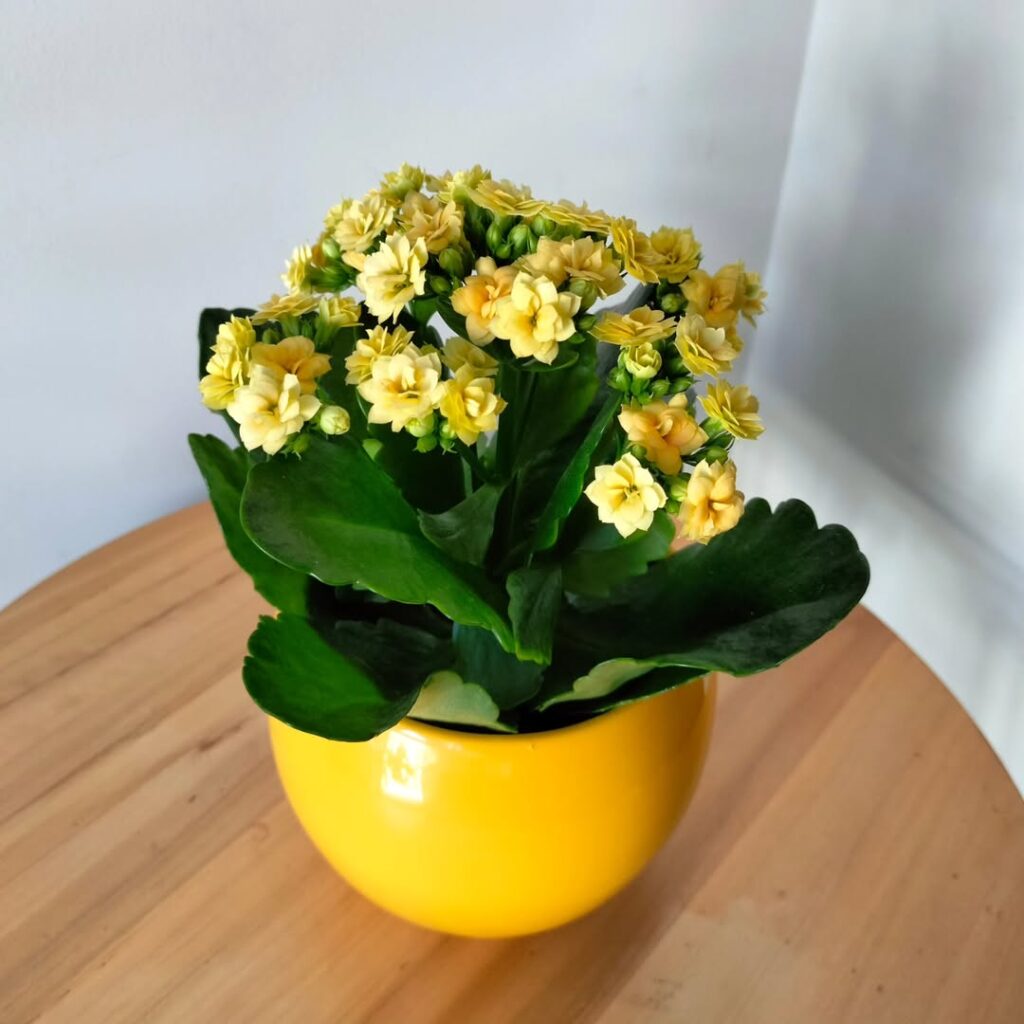
Kalanchoe species are popular indoor succulents prized for their abundant clusters of small, colorful flowers that bloom for extended periods. These compact plants produce vibrant blooms in shades of red, orange, pink, yellow, and white, making them excellent choices for brightening indoor spaces. Common varieties like Kalanchoe blossfeldiana offer reliable flowering cycles when properly maintained, while their thick, scalloped leaves add year-round ornamental value.
- Light: Bright, indirect sunlight; morning sun is ideal; protect from intense afternoon sun
- Water: Allow soil to dry between waterings; reduce watering during winter months
- Soil: Well-draining potting mix designed for succulents and cacti
- Temperature: 60-85°F (15-29°C); protect from cold drafts
- Humidity: Tolerates average indoor humidity levels
- Fertilizer: Feed with balanced liquid fertilizer monthly during growing season
- Container: Pots with drainage holes to prevent root rot
- Pruning: Remove spent blooms to encourage new flower production
7. Jasmine
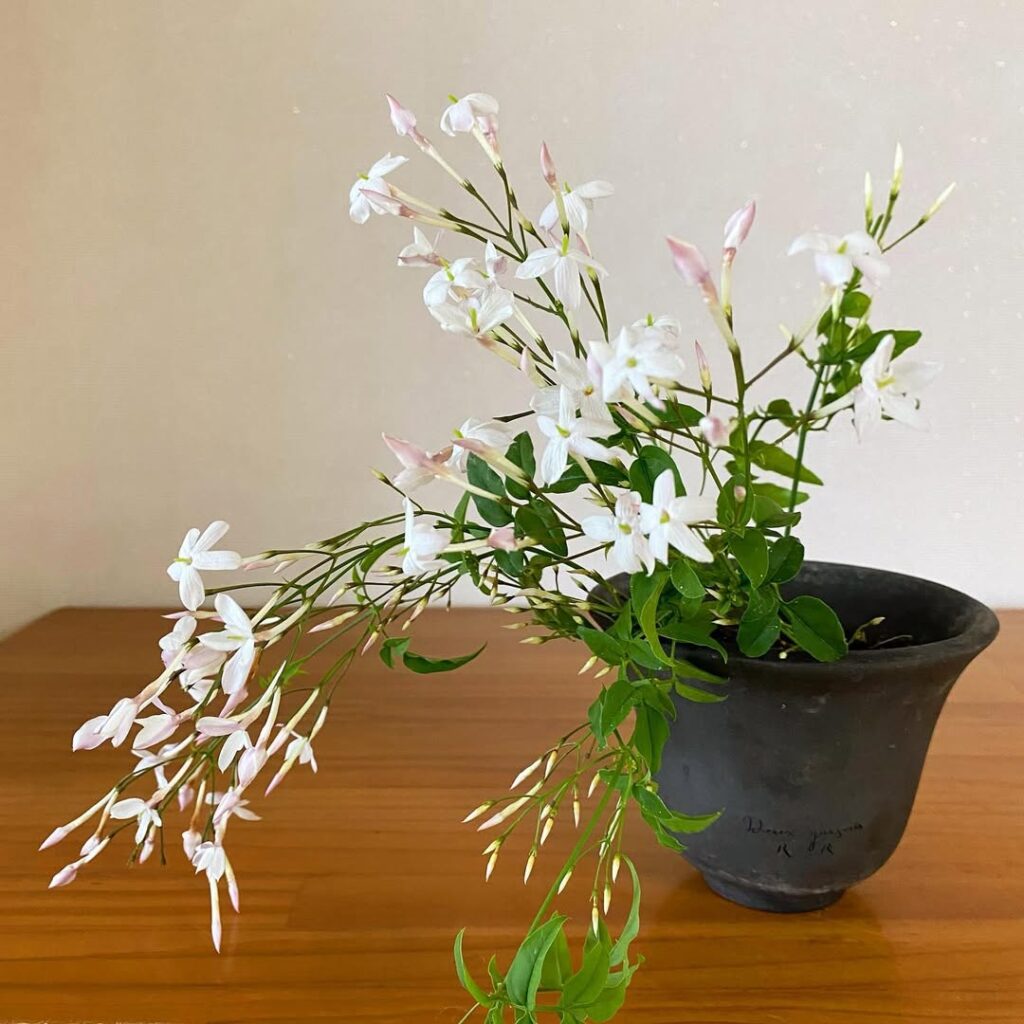
Trailing Jasmine (Jasminum polyanthum) is a fast-growing indoor vine that produces clusters of delicate white flowers with a powerful sweet fragrance. This variety typically blooms within 4-6 weeks of proper care during late winter to early spring, making it one of the quicker indoor flowering plants. The vining stems can reach lengths of 20 feet or more, creating an elegant cascading effect when grown in hanging baskets or trained on trellises, while the dark green pinnate leaves provide an attractive backdrop for the star-shaped blooms.
- Light: Bright, indirect sunlight; morning sun is beneficial; protect from harsh afternoon sun
- Water: Keep soil consistently moist but not waterlogged; water when top inch of soil feels dry
- Soil: Well-draining, fertile potting mix rich in organic matter
- Temperature: 60-75°F (15-24°C); cooler nights around 55°F (13°C) encourage blooming
- Humidity: Moderate to high; regular misting benefits growth
- Fertilizer: Monthly feeding with balanced, water-soluble fertilizer during growing season
- Training: Requires support structure like trellis or stakes for ideal growth
8. Wax Begonia
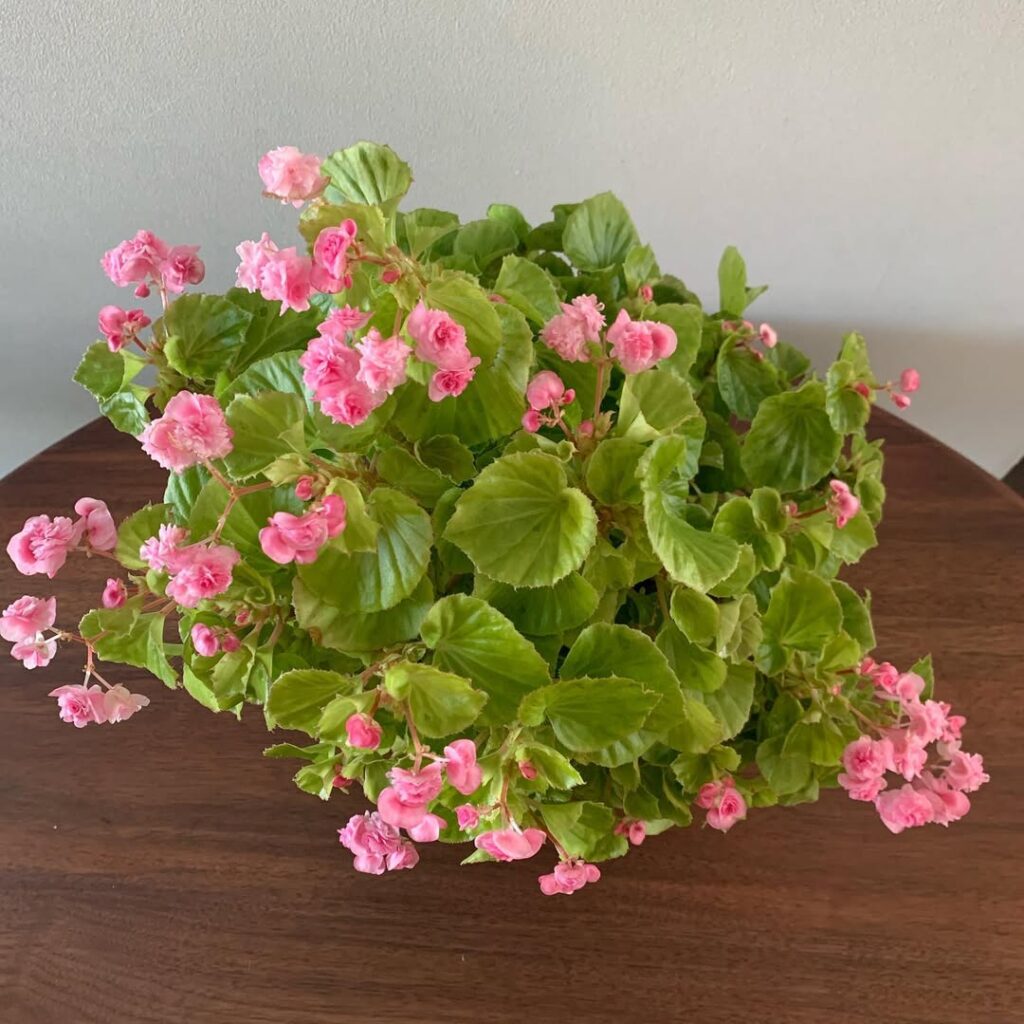
Wax begonias are fast-growing flowering plants that offer vibrant blooms in shades of pink, red, white, orange, and yellow. These adaptable plants produce delicate flowers atop waxy, often uniquely patterned foliage, making them excellent indoor specimens. With proper care, begonias can flower continuously for several months, typically beginning to bloom within 8-12 weeks after planting from tubers or young plants.
- Light: Bright, indirect sunlight; avoid direct sun which can scorch leaves
- Water: Keep soil consistently moist but not waterlogged; water when top inch of soil feels dry
- Soil: Well-draining, rich potting mix with high organic content
- Humidity: Moderate to high humidity (50-70%)
- Temperature: 65-75°F (18-24°C)
- Fertilizer: Feed every 2-3 weeks during growing season with balanced liquid fertilizer
- Container: Pot with drainage holes; shallow containers work well for most varieties
- pH: Slightly acidic soil (6.0-6.5)
9. Morning Glory
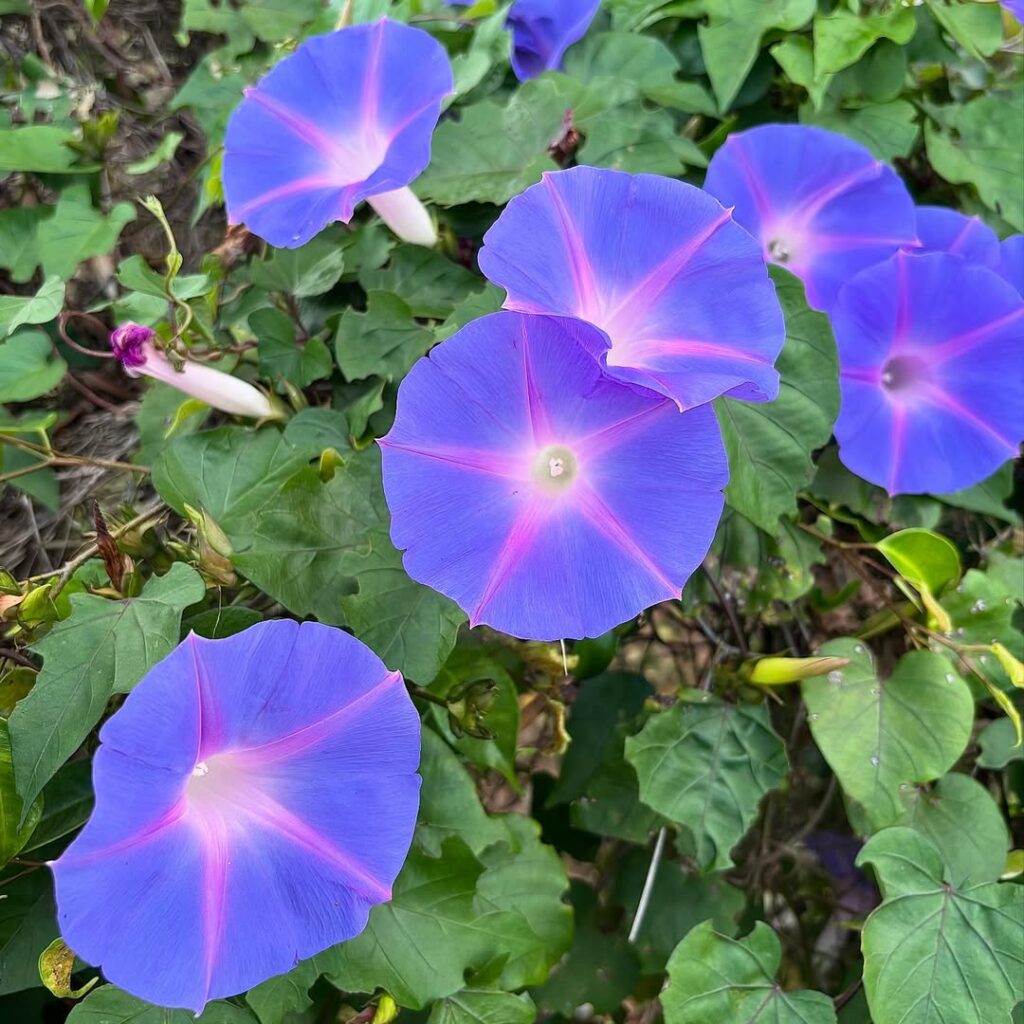
Morning Glory vines are rapid-growing annual climbers that can reach heights of 10-15 feet indoors when properly supported. While typically grown outdoors, these vigorous plants adapt well to indoor environments, producing funnel-shaped blooms in shades of blue, purple, pink, or white that open in the morning and close by afternoon. When grown indoors, they can flower within 6-8 weeks of planting, making them one of the fastest-flowering indoor vines available to home gardeners.
- Light: Requires 6-8 hours of direct sunlight daily; place near south-facing windows
- Water: Keep soil consistently moist but not waterlogged; water when top inch of soil feels dry
- Soil: Well-draining potting mix with added organic matter
- Temperature: 65-85°F (18-29°C)
- Humidity: Moderate humidity levels (40-60%)
- Support: Needs strong trellises, strings, or stakes for climbing
- Container: Deep pot with adequate drainage holes
- Fertilizer: Monthly feeding with balanced, water-soluble fertilizer during growing season
10. Crown of Thorns
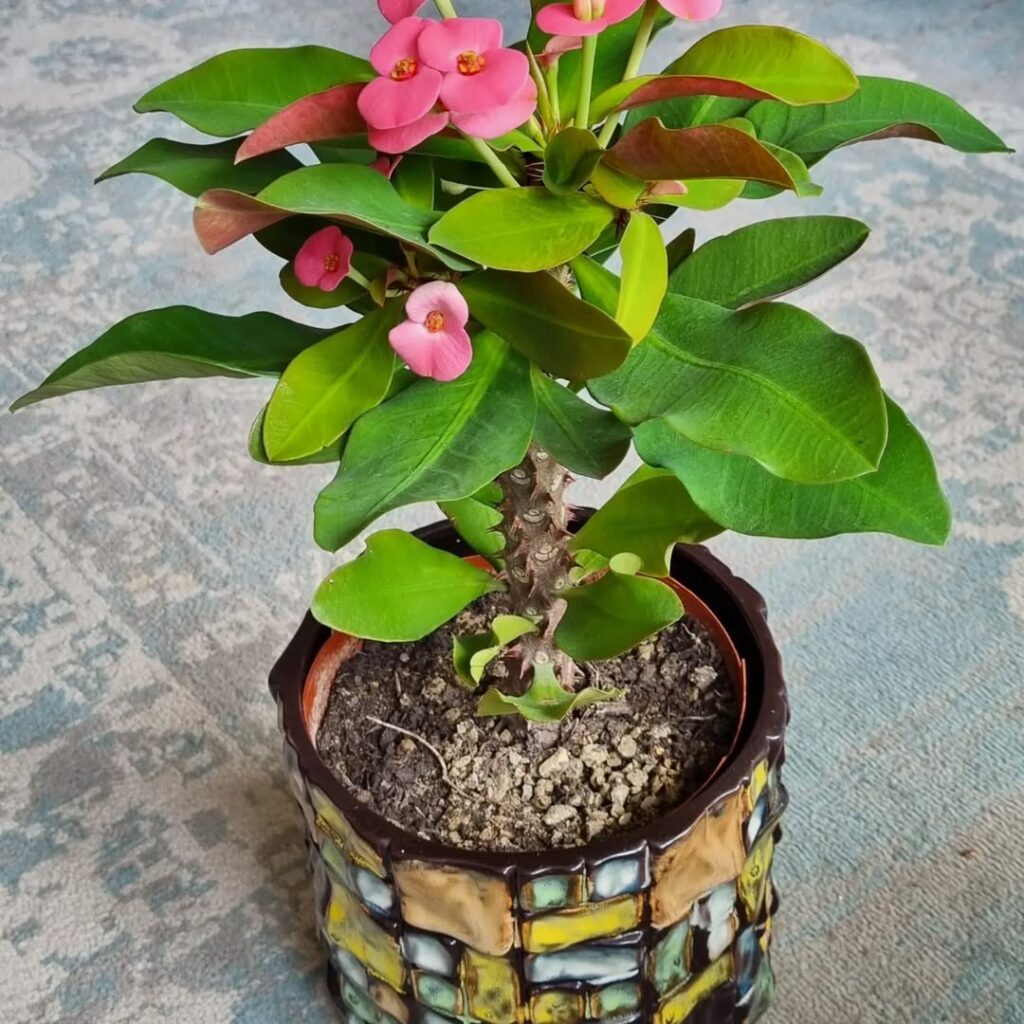
Crown of Thorns (Euphorbia milii) is a fast-flowering succulent that can bloom almost continuously throughout the year when given proper care. Native to Madagascar, this plant features thick, spiny stems and small, oval-shaped leaves, with clusters of tiny flowers surrounded by colorful bracts in shades of red, pink, yellow, or white. Despite its intimidating name and thorny appearance, it’s a relatively low-maintenance indoor plant that typically starts producing blooms within a few months of planting.
- Light: Bright, direct sunlight for 4-6 hours daily; can tolerate some partial shade
- Water: Allow soil to dry between waterings; water sparingly in winter
- Soil: Well-draining, sandy potting mix
- Temperature: 65-75°F (18-24°C)
- Humidity: Adaptable to average indoor humidity levels
- Fertilizer: Light feeding with balanced fertilizer every 6-8 weeks during growing season
- Container: Pot with good drainage holes
- pH: 6.1-7.5
11. Hyacinth

Hyacinths are popular indoor flowering bulbs known for their intensely fragrant blooms and vibrant colors ranging from deep purple to pink, white, and blue. These spring-blooming plants typically flower within 2-3 weeks when forced indoors, producing dense spikes of star-shaped flowers atop sturdy stems. Hyacinth bulbs are often “pre-chilled” before indoor planting to simulate winter conditions, which triggers the blooming process.
- Light: Bright indirect light; direct sunlight can cause flowers to fade quickly
- Water: Keep soil consistently moist but not waterlogged; reduce watering after blooming
- Soil: Well-draining potting mix with added organic matter
- Temperature: Cool conditions (60-65°F) during growth; cooler temperatures extend bloom time
- Planting depth: Position bulb with tip slightly exposed above soil surface
- Container: Use pots with drainage holes; can be grown in water using special forcing vases
- Humidity: Moderate humidity levels; avoid dry air
- Fertilizer: Not necessary during forcing period as bulbs contain stored nutrients
12. Chinese Lantern
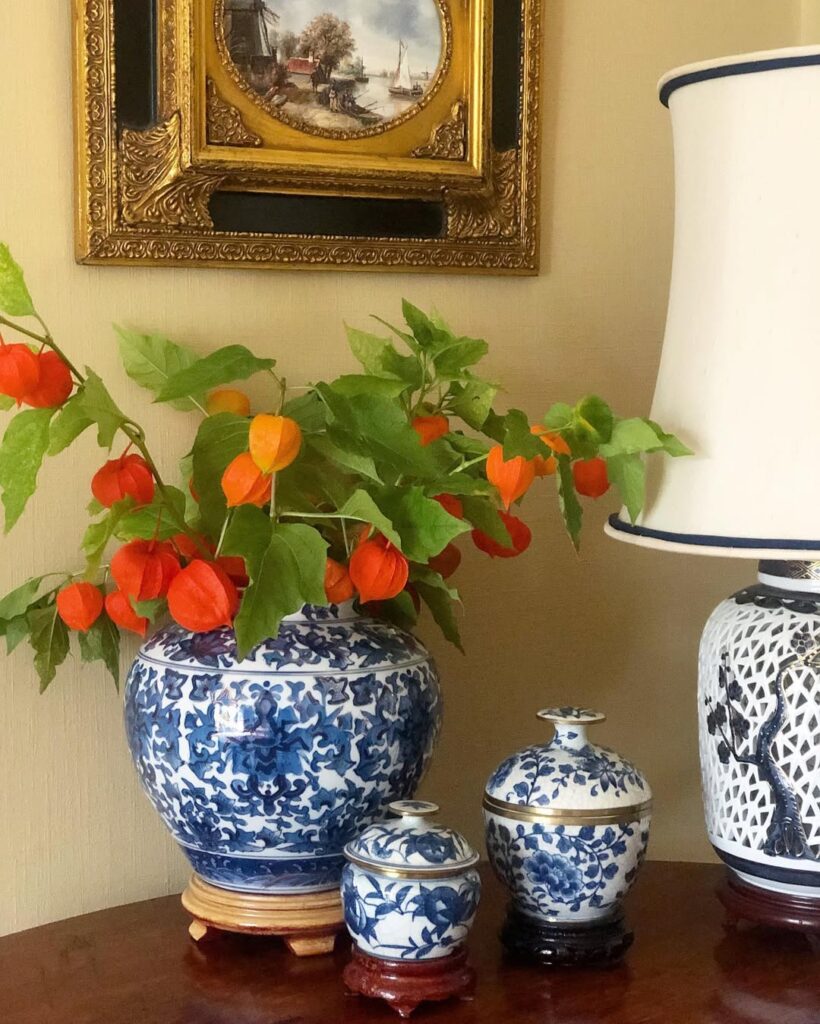
Chinese Lantern (Physalis alkekengi) is a fast-growing plant that produces striking orange-red papery husks resembling miniature paper lanterns, which enclose small berries. While typically grown outdoors, it can thrive indoors with proper care. The plant usually flowers within 60-70 days after germination, making it an excellent choice for those seeking quick blooms. The decorative husks appear in late summer to fall and can be dried for long-lasting ornamental displays.
- Light: Bright, indirect sunlight; minimum 6 hours daily; can tolerate some direct morning sun
- Water: Keep soil consistently moist but not waterlogged; water when top inch of soil feels dry
- Soil: Well-draining potting mix rich in organic matter; pH 6.0-7.0
- Temperature: 65-75°F (18-24°C)
- Humidity: Average room humidity (40-50%)
- Container: Deep pot with drainage holes to accommodate spreading roots
- Fertilizer: Monthly feeding with balanced, water-soluble fertilizer during growing season
- Spacing: One plant per 12-inch pot due to spreading nature
13. Desert Rose
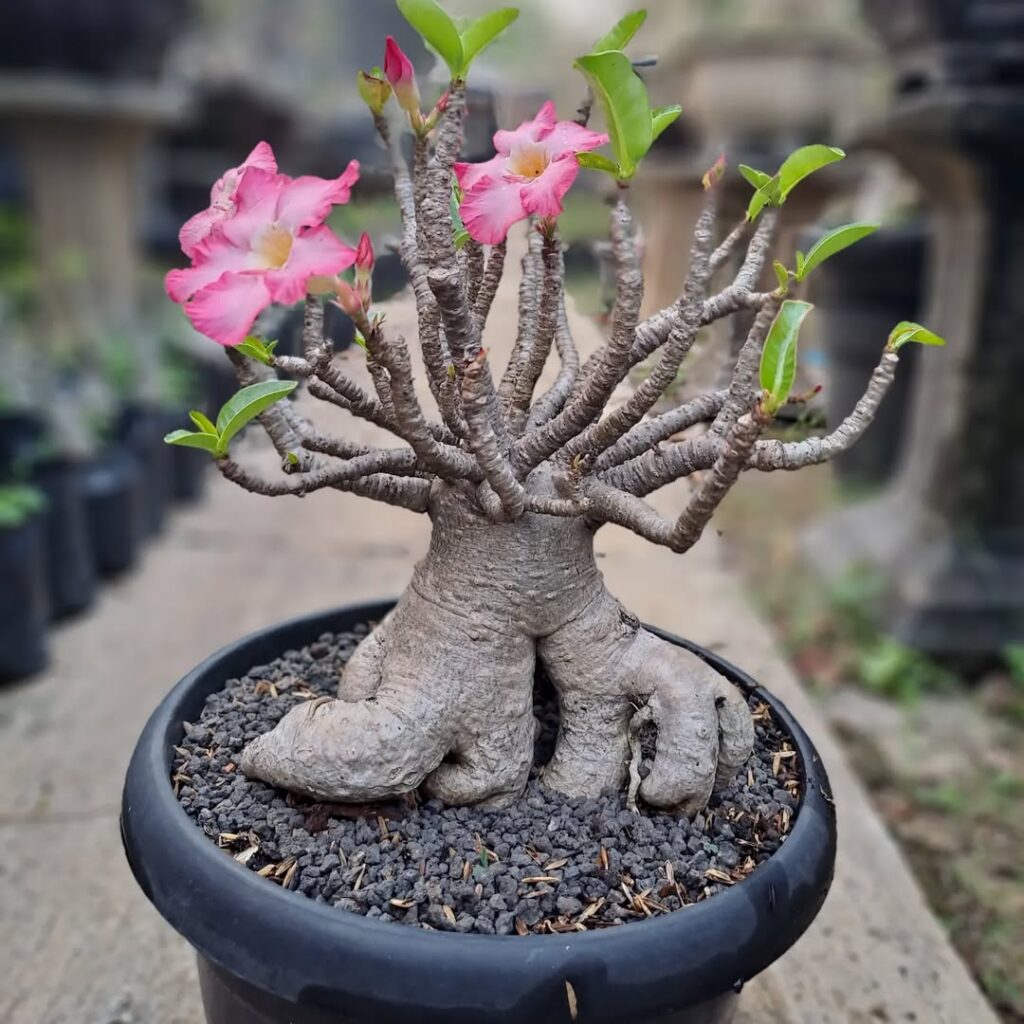
The Desert Rose (Adenium obesum) is a striking succulent that produces vibrant pink, red, or white flowers within its first growing season. Despite its name, it’s not actually a rose but rather a member of the Apocynaceae family, featuring a thick, swollen trunk and glossy green leaves. When grown indoors, this compact plant typically reaches 2-4 feet tall and blooms multiple times throughout the year, with each flower lasting several days to weeks.
- Light: Requires full sun, at least 6 hours of direct sunlight daily; place near south-facing window
- Water: Water thoroughly when soil is dry; reduce watering in winter; prone to root rot if overwatered
- Soil: Well-draining cactus or succulent mix with added perlite and sand
- Temperature: Prefers warm conditions between 65-85°F (18-29°C)
- Humidity: Tolerates average indoor humidity; no special requirements
- Fertilizer: Feed monthly with balanced fertilizer during growing season
- Container: Must have excellent drainage holes; prefer shallow, wide pots
- Winter Care: Reduce watering and stop fertilizing; maintain temperatures above 50°F (10°C)
14. Purple Passion Vine
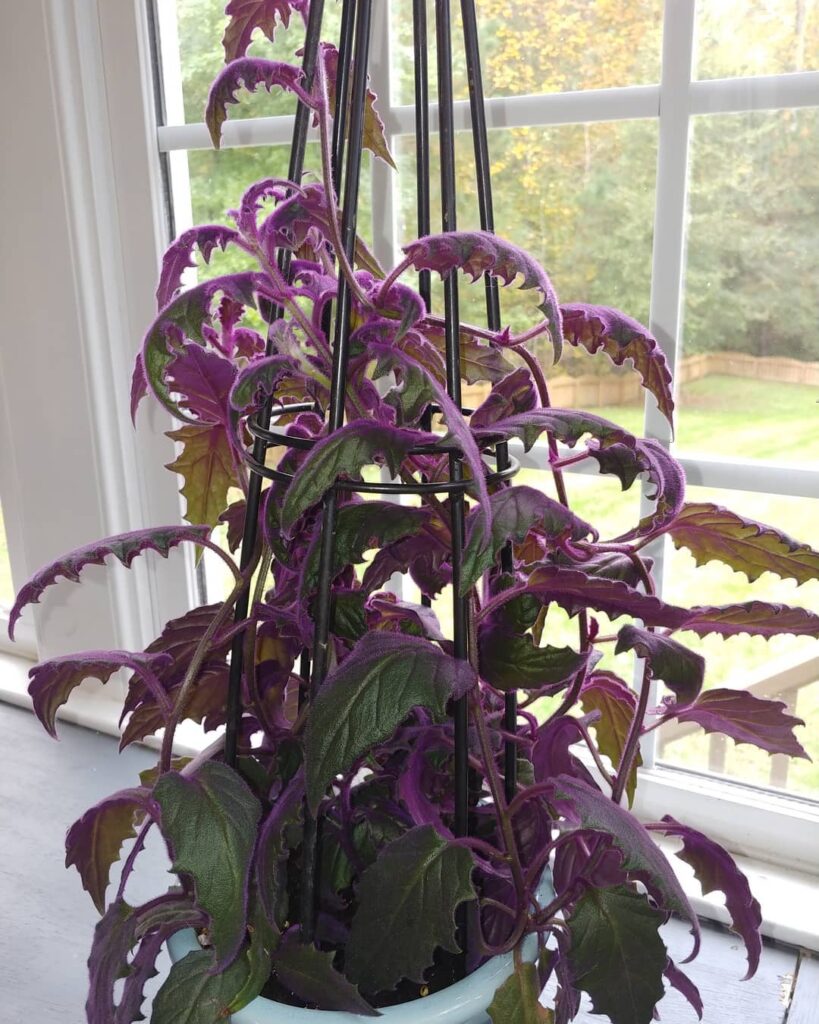
The Purple Passion Vine (Gynura aurantiaca) is a unique flowering plant known for its striking purple-tinged foliage covered in soft, velvety hairs that give it an iridescent appearance. While primarily grown for its distinctive leaves, this fast-growing vine produces small orange flowers throughout the year, though many growers remove them due to their somewhat unpleasant fragrance. The plant’s trailing stems make it ideal for hanging baskets or climbing supports indoors, where it can reach lengths of 3-4 feet.
- Light: Bright, indirect sunlight; protect from intense afternoon sun
- Water: Keep soil consistently moist but not waterlogged; water when top inch of soil feels dry
- Soil: Well-draining, rich potting mix with added organic matter
- Temperature: 60-75°F (15-24°C)
- Humidity: Moderate to high humidity; benefits from regular misting
- Fertilizer: Feed monthly during growing season with balanced, water-soluble fertilizer
- Pruning: Trim regularly to maintain shape and promote bushier growth
- Container: Use pots with drainage holes to prevent root rot
15. Angel Wing Begonia
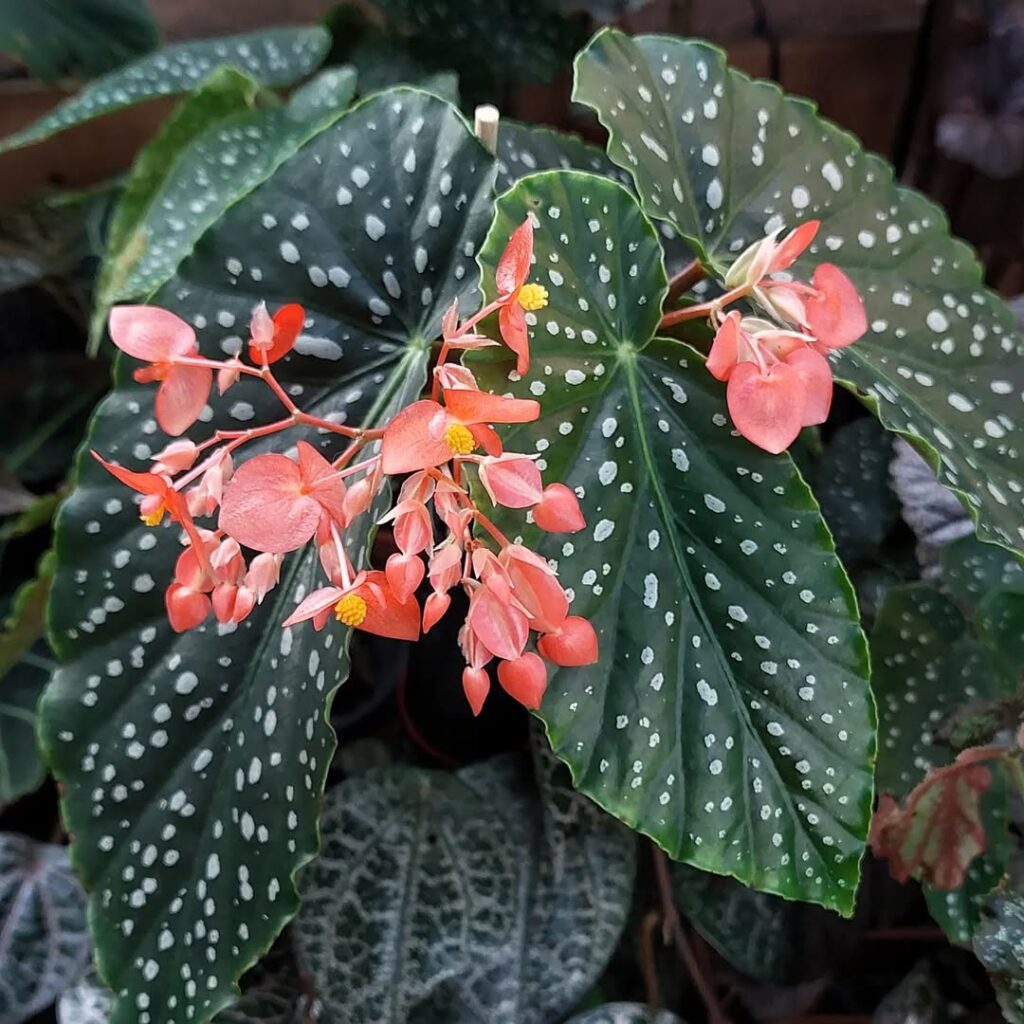
Angel Wing Begonias are cherished indoor plants that earn their name from their distinctive wing-shaped leaves and can produce blooms within 2-3 months of planting. These fast-growing plants feature clusters of delicate pink, red, or white flowers that dangle elegantly among their dark green, silver-spotted foliage. When properly cared for, they can flower continuously throughout most of the year, making them an excellent choice for indoor gardeners seeking quick and long-lasting blooms.
- Light: Bright, indirect sunlight; avoid direct afternoon sun which can scorch leaves
- Water: Keep soil consistently moist but not waterlogged; water when top inch of soil feels dry
- Soil: Well-draining, rich potting mix with high organic content
- Humidity: Moderate to high (50-70%); use humidity tray or mist regularly
- Temperature: 65-75°F (18-24°C)
- Fertilizer: Monthly feeding with balanced, water-soluble fertilizer during growing season
- Pot: Container with drainage holes to prevent root rot
- Pruning: Regular pinching of stem tips to encourage bushier growth and more blooms
